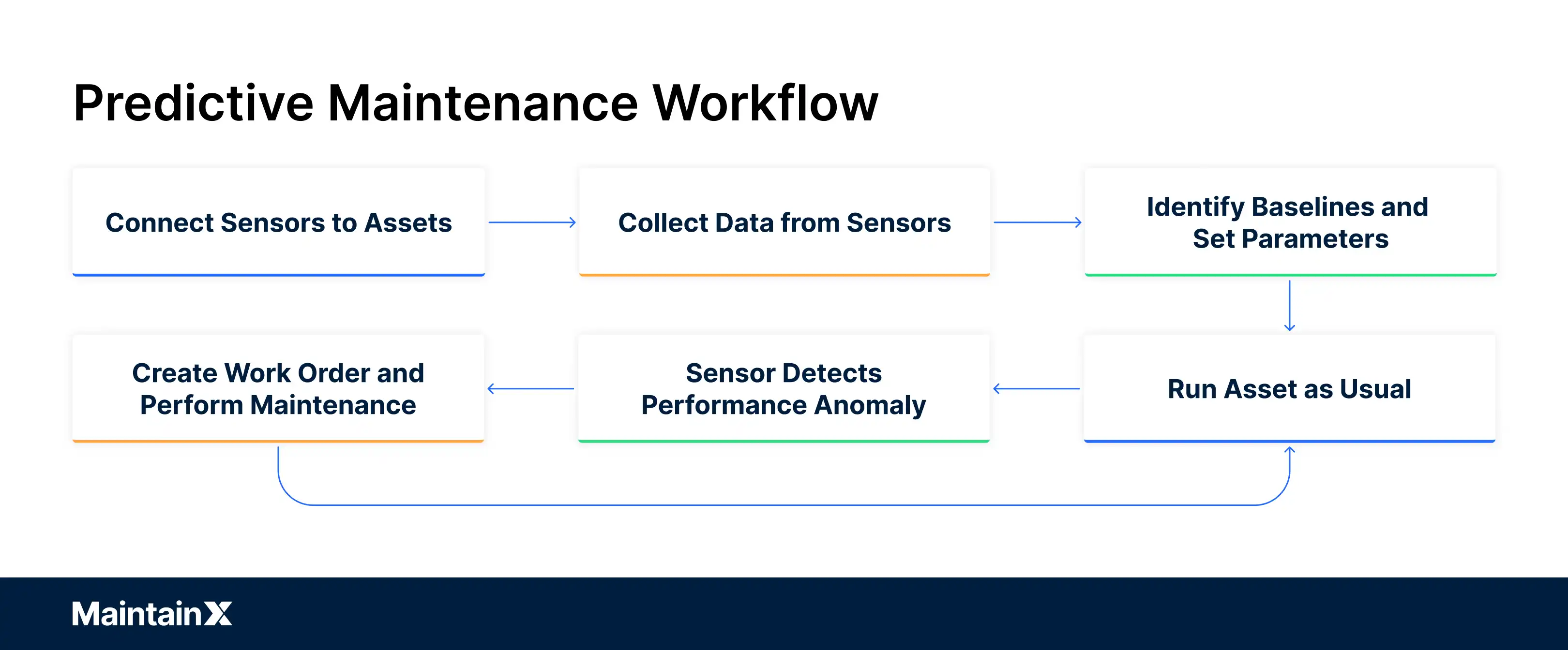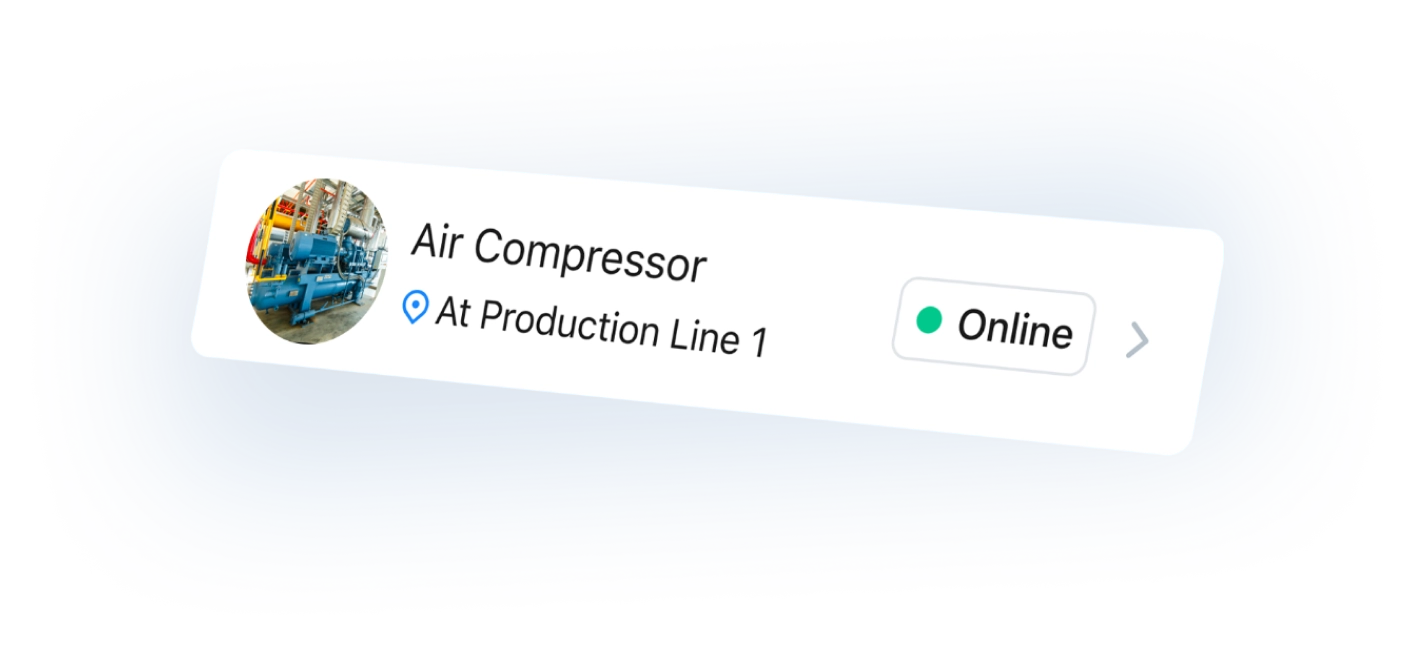As a facility manager, you share a common goal with your peers across every industry: to minimize downtime by catching and resolving issues as soon as possible. For decades, that part hasn't changed.
What has changed, though, is how you go about it. For years, you had to rely on fixed maintenance schedules and hope nothing broke in between tune-ups. There just wasn't a better option.
Now, there is. Predictive maintenance uses real-time data and IoT sensors to forecast when machines are likely to fail so your team can act before they do.
In this post, we’ll unpack what predictive maintenance looks like today, how it stacks up against preventive maintenance, and why more and more organizations are building it into their maintenance strategy.

Key takeaways
- Predictive maintenance uses real-time data, sensor feedback, and predictive analytics to forecast equipment failures before they occur.
- It's different from preventive maintenance, which relies on a fixed schedule. Predictive maintenance is based on actual equipment conditions at any given time.
- Done right, it leads to a range of benefits: Equipment lasts longer, unexpected breakdowns are minimized, and overall maintenance costs drop.
- Cutting-edge techniques like vibration analysis, oil sampling, ultrasonic testing, and thermography play a big role in detecting early signs of wear and tear.
- A good Computerized Maintenance Management System (CMMS) complements these technologies to help teams better collect and make sense of their predictive maintenance data.
How predictive maintenance works
Most mechanical equipment doesn’t fail without warning. There’s usually some kind of signal, like a strange vibration or slight temperature spike, that happens ahead of time. The problem is that these signals can be extremely subtle and easy to miss without the help of monitoring tools.
Predictive maintenance (PdM) is the practice of leveraging tools like IoT sensors to spot early warning signs and address them before they turn into full-blown equipment failures. These tools enable hyper-accurate condition monitoring techniques like vibration analysis, oil sampling, and thermography to detect anomalies that your team could never have noticed on their own. Once you collect the sensor data, machine-learning algorithms analyze it to see whether any interventions are needed.
At the end of the day, predictive maintenance has three simple goals:
- Maximize asset uptime by avoiding disruptive breakdowns.
- Reduce maintenance costs by eliminating unnecessary maintenance work.
- Extend asset lifespans by fixing small problems before they cause equipment failures.
Preventive vs Predictive Maintenance
Preventive and predictive maintenance both aim to do the same thing: stop equipment failures before they happen. But the way they get there is fundamentally different.
Let’s start with preventive maintenance. It’s time-based, meaning checks and tune-ups are scheduled at set intervals, like once a quarter or every 5,000 hours in operation. You do the work whether the equipment actually needs attention or not.
It's a better approach than simply waiting until equipment starts malfunctioning to intervene, but it's far from perfect. Equipment rarely breaks down in clean, predefined windows. There's a strong chance that you'll incur unnecessary maintenance costs and that issues will pop up between scheduled checks.
Predictive maintenance, on the other hand, aims to detect signs of wear and tear immediately so your team can take action as soon as possible. In other words, it's condition-based rather than calendar-based.
These signals can be incredibly subtle. A small vibration change or temperature spike could indicate an imminent breakdown. However, it may be impossible to notice with the naked eye. That's why maintenance personnel rely on things like IoT sensors to detect the signals for them. You can then feed this sensor data into machine-learning algorithms that recommend when and how to act to avoid a breakdown.
Predictive maintenance is far more precise than preventive maintenance. Your team knows exactly when and where to intervene and doesn't have to waste their time checking equipment that’s perfectly functional. However, the sensors and software needed to support your team don’t come cheap. Plus, you need to invest in training team members on how to interpret and use sensor data.
So which is better? The truth is, most high-performing maintenance teams don’t choose one or the other. They use a mix of both. Preventive maintenance creates a consistent foundation, while predictive maintenance adds the layer of intelligence that helps you fine-tune your strategy.
Benefits of predictive maintenance
Predictive maintenance may sound like a futuristic concept, but it's already delivering real results across industries.
Here’s what these benefits actually look like on the ground:
Minimize unplanned downtime
Unplanned downtime is one of the most disruptive (and expensive) challenges your maintenance team can face. Even if everything else is working fine, one faulty machine can bring your entire production to a halt. While no system can promise 100% uptime, a properly implemented predictive maintenance program helps your team stay one step ahead of avoidable issues.
Optimize parts and labor costs
Preventive maintenance schedules part replacements at fixed intervals, even if they're working fine. Doing so drives up operating costs unnecessarily.
Predictive maintenance takes a more targeted approach. Equipment sensors can detect exactly when a part needs to be replaced and alert teams to take action accordingly. This saves you money on spare parts and labor while improving your risk mitigation strategy.
Extend equipment life
Every asset has a fixed lifespan, but you can keep equipment running longer with good maintenance practices. Predictive maintenance tools can tell you both what interventions are needed (like lubrication) and where via ultrasonic testing, vibration analysis, or oil analysis. This helps you maximize equipment life in a cost-efficient way.
Improve safety and compliance
Unexpected equipment failures are one of the biggest drivers of on-the-job injuries. Predictive maintenance keeps your team safer by reducing the likelihood that a broken machine will cause anyone in your facility harm. It also makes audit prep easier, since all your maintenance data is tracked in real time and organized through tools like a CMMS.
Challenges and requirements
Predictive maintenance offers plenty of upsides, but it’s not a plug-and-play solution. Like any major operational change, it’s important to understand the key challenges you might face before deploying it at scale.
Upfront cost of sensors and analytics
Like we talked about earlier, a modern predictive maintenance system requires a mix of hardware (IoT sensors) and software (machine learning and predictive analytics). Getting all of this set up can take hefty capital investments and training. However, most organizations more than make up for these upfront costs in the long run through:
- Improved equipment reliability
- Optimized maintenance schedules
- Longer asset lives
- Less machine downtime
Managing the cultural shift
Your team might experience culture shock when shifting from regular, scheduled maintenance to a predictive maintenance process. Rather than knowing exactly when they need to service each machine, teams need to be prepared to step in whenever the sensors tell them to. That takes some getting used to.
Be patient with your team as they develop familiarity and trust in this new process. Eventually, most come to realize that this framework gives them more time in their days and prevents all kinds of headaches.
Data integration and CMMS connectivity
Predictive maintenance software performs at its best when it works seamlessly with the rest of your maintenance management stack, especially your CMMS. Without smooth data integration, you risk clunky workflows and a loss of visibility into key insights. Prioritizing API compatibility and workflows that connect the dots between fault detection and work order execution can go a long way here.
Yes, predictive maintenance has a learning curve. Yes, it requires some upfront lift. But with the right planning and tools in place, these early hurdles are well worth the long-term payoff.
Support predictive maintenance with a CMMS
A CMMS like MaintainX gives you the digital infrastructure to support predictive maintenance at scale. It helps maintenance teams:
- Automatically collect data and log it in the system.
- Schedule maintenance tasks based on real-time asset performance.
- Track work orders tied to condition-based triggers.
- Generate reports for audits and compliance.
To learn more, check out our guide to the best predictive maintenance software.
FAQs
Different equipment requires different types of predictive maintenance. But in general, most facilities tend to use three main types of predictive maintenance: vibration analysis, ultrasonic testing, and oil analysis.
Let’s break each one down.
1. Vibration analysis
If you’re working with rotating equipment like motors, pumps, or compressors, vibration analysis is often your first line of defense. The idea is simple: Machines vibrate while in use, and when something’s off, those vibrations change.
These tiny vibration changes are usually imperceptible to the naked eye. That's why teams rely on IoT sensors to monitor things like vibration speed, amplitude, and frequency. If a sensor picks up an anomaly, such as a machine shaking more than it should be, it flags it for further analysis. Sometimes, these tiny changes are harmless. But in other cases, it could be an early sign of misalignment, imbalance, loose components, or bearing wear.
2. Ultrasonic testing
Ultrasonic testing listens for sounds we can’t hear. It's an advanced technology, but the concept is pretty intuitive: Stressed or failing equipment gives off high-frequency signals that are easy to miss without advanced sensors.
Ultrasonic testing picks up on those signals, helping you catch problems like:
- Compressed air or gas leaks
- Electrical discharge (like arcing or tracking)
- Poor lubrication in bearings
It’s a great option for detecting subtle issues across both mechanical systems and electrical components.
3. Oil analysis
Think of oil analysis as a blood test for your machines. Instead of just looking at whether there’s enough lubricant in the system, it tells you what’s happening inside the equipment by analyzing what’s floating in the oil.
Oil analysis helps you monitor:
- Contamination levels
- Water content
- Viscosity
- Metal particles (which can point to internal wear)
It’s especially useful in heavy-duty equipment like engines, gearboxes, and hydraulic systems.
Most good predictive maintenance strategies combine all three of these approaches, along with others specific to the facility.
Key predictive maintenance technologies include IoT sensors, machine learning, thermography, ultrasonic devices, and CMMS platforms for real-time condition monitoring and workflow management.
Benefits of predictive maintenance include lower maintenance costs, fewer breakdowns, extended equipment lifespan, better safety, and more efficient use of resources through condition-based maintenance planning.
See MaintainX in action







